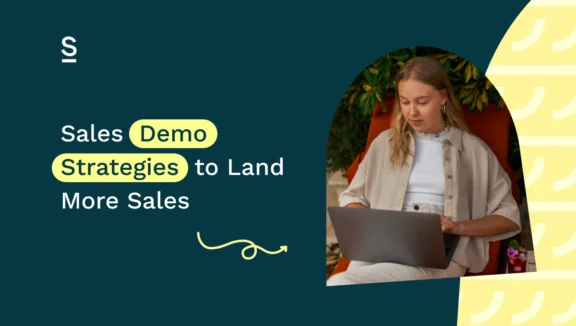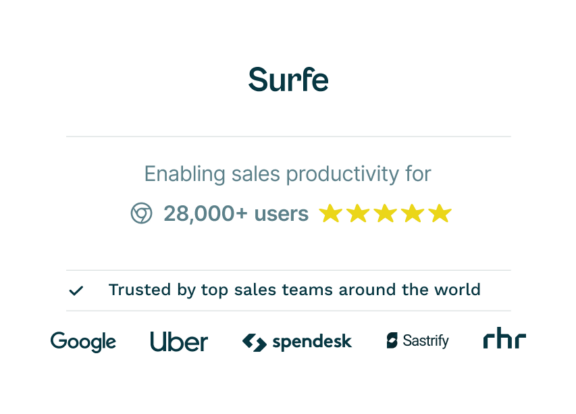Sales Demo Strategies to Land More Conversions

Sales demos are the gateway to closing deals. It’s where the prospect meets the product, and if done well, it can transform hesitation into a handshake. Think of a sales demo as your chance to not just present a solution, but to make your prospect feel, “This is exactly what I need!”
A killer demo builds trust, showcases value, and addresses the prospect’s pain points. It’s where the conversation shifts from “maybe” to “how soon can we get started?” So how can you level up your demo game to get your prospects to sign on the dotted line?
In a rush? Skip ahead:
Preparing for a Successful Sales Demo
As the old saying goes, failing to prepare is preparing to fail. And in sales, walking in blind just won’t cut it— each demo must feel as if it was crafted just for that particular prospect. Here’s how to do it right:
Research Your Prospect Thoroughly
Know Their Business Needs:
Before even thinking about the demo, dive deep into your prospect’s business. What industry are they in? What current market trends are affecting them? Understanding these details will allow you to connect the dots between their challenges and your solution.
Understand Their Pain Points:
Once you have a good handle on their business, focus on their specific pain points. Are they struggling with inefficiency? Do they need to scale fast? Your product is the answer to their problems, but first, you have to show them you get what’s keeping them up at night.
Personalize the Demo:
Your solution could work for a thousand different businesses, but that’s not what they want to hear. Personalize the demo to showcase how your product specifically addresses their challenges. Make it clear that you understand their unique situation and have the right tool to make it better.
Set Clear Objectives for the Demo
Define the Purpose:
Is your goal to secure a follow-up meeting? Get a verbal commitment? Close the sale? You need to walk into the demo with a clear objective in mind. Knowing what you want to achieve keeps the conversation focused and purposeful.
Align Objectives with the Prospect’s Goals:
It’s not just about your goals, though—your objectives should align with the prospect’s desires. Frame your demo in a way that makes it clear how your product will help them reach their goals. Think of it like this: your success is tied to their success.
Plan the Flow of the Demo
Create a Structure:
Organizing your demo into clear sections helps maintain a logical flow. A good demo will typically have four parts: an introduction, a discussion of the problem, the solution demonstration, and next steps. This not only keeps you on track but helps the prospect follow along without getting lost.
Time Management:
Don’t fall into the trap of giving too much information. Keep your demo concise and focused on what truly matters to your prospect. When in doubt, trim down. Respecting the prospect’s time shows that you value their schedule and understand the importance of efficiency.
Delivering an Engaging and Impactful Demo
The actual delivery of the demo is where the magic happens. It’s not enough to talk about your product; you need to make the demo a compelling experience that keeps the prospect engaged and eager to learn more.
Start by Setting the Stage
Introduction:
Begin by outlining what will be covered in the demo. Confirm the key objectives from the prospect’s perspective and ensure that everyone is on the same page. This helps build anticipation and ensures the demo starts with purpose.
Build Rapport:
Take a moment to establish a connection. Reference their business and their challenges right from the start. Something as simple as, “I understand you’re looking to streamline your workflow,” instantly shows you’ve done your homework.
Focus on the Prospect’s Pain Points
Make it Relevant:
No one wants to sit through a generic product walkthrough. Tailor your demo to the prospect’s specific pain points. Show them exactly how your product solves their unique problems and why it’s the perfect fit for them.
Use Real-World Scenarios:
Give examples of how other companies in their industry are using your product. This gives your demo a sense of real-world application, making it easier for the prospect to visualize themselves benefiting from it.
Example: “Here’s how companies like yours have been able to cut their project turnaround time by 25% using this feature.”
Highlight Key Features that Solve the Prospect’s Problems
Feature Demonstration:
Rather than showing off every feature, zero in on the ones that address the prospect’s pain points. Features are important, but it’s the benefits they bring that seal the deal.
Show Benefits, Not Just Features:
Take it one step further by translating those features into tangible benefits. Don’t just show them a new dashboard—show them how that dashboard helps their team be 30% more productive. It’s not about what your product does; it’s about what it does for them.
Example: “This feature will allow your team to collaborate seamlessly across departments, cutting down on project delays and boosting efficiency.”
Engage the Prospect Throughout the Demo
Ask Questions:
Make the demo interactive. Check in regularly to ensure your prospect is following along and to address any questions or concerns. This prevents the demo from feeling like a monologue.
Encourage Interaction:
Whenever possible, let the prospect engage with the demo. Allow them to explore certain features or try out parts of the product themselves. This hands-on approach makes the demo more memorable.
Example Questions:
“Does this align with the challenges you mentioned?”
“Would you like to try this feature out yourself?”
Use Visuals and Narratives
Visual Storytelling:
A picture is worth a thousand words. Integrate visuals—charts, case studies, or before-and-after scenarios—to illustrate your points. This helps make the demo more engaging and ensures key messages stick.
Tell a Story:
Frame the demo as a journey, starting from the problem and moving toward the solution. Walk the prospect through how your product solves their specific pain points and makes their life easier. Everyone loves a good story—especially when they’re the hero.
Killer Closing Strategies
The end of the demo is where you shift from showcasing your product to driving action. How you close the demo will determine whether the conversation moves forward or stalls out.
Recap Key Benefits
Summarize the Value:
Before wrapping up, reiterate the key benefits of your product, specifically how they address the prospect’s pain points. A quick recap solidifies the value in their mind and reinforces why your solution is the right choice.
Reinforce Urgency:
Don’t let the momentum fade. Explain why now is the best time to move forward—whether it’s due to industry trends, competitive advantage, or the potential ROI they could be losing by waiting.
Encourage a Clear Next Step
Call to Action:
End with a specific call to action. Whether it’s scheduling a follow-up, setting up a trial, or discussing a contract, make sure you have a defined next step. Avoid vague conclusions—ask for the commitment.
Example: “Would you be available for a deeper dive next week to go over implementation?”
Address Objections
Handle Concerns Early:
Expect objections and be ready for them. Whether it’s pricing, integration concerns, or feature gaps, stay calm and address them head-on. Use case studies or data to show how others have overcome the same objections.
Use Objection Handling Techniques:
Handles objections by asking clarifying questions and exploring the objection further. By understanding their concerns more deeply, you can provide a tailored response that diffuses the objection without derailing the conversation.
Provide Supporting Materials
Follow-Up Documents:
Offer to send supporting materials after the demo—whether it’s a product brochure, a case study, or pricing information. These materials keep the conversation going and ensure the prospect stays engaged.
Improving Your Demo Process Over Time
Great demos aren’t born overnight— they’re refined and optimized as your team meets more prospects. But what makes a demo successful, and how can you hone your pitch?
Track Demo Success Metrics
Key Metrics to Monitor:
Keep tabs on demo-to-conversion rates, engagement levels during the demo, and follow-up meeting requests. This data will give you insight into what’s working and where you can improve.
Why Metrics Matter:
By analyzing these metrics, you’ll be able to fine-tune your approach, making each demo more effective than the last.
Gather Feedback from Prospects
Post-Demo Surveys:
Ask prospects for feedback. Find out what resonated with them and what didn’t. This information is gold for improving future demos.
Incorporate Feedback:
Use this feedback to tweak your demo—whether it’s highlighting different features, adjusting the flow, or improving engagement techniques.
Continuously Refine the Demo
Test Different Approaches:
Not every prospect is the same, and neither should every demo be. Try different formats—shorter demos for busy executives, or more interactive ones for hands-on prospects.
Adapt to New Learnings:
As your product evolves, so should your demo. Regularly update it to reflect the latest features and customer pain points.
Let’s Wrap It Up!
Mastering the art of a sales demo can feel daunting, but the key is to approach it as a conversation, not a presentation. It’s your opportunity to show the prospect how your product solves their specific problems, and the way you conduct the demo can make or break that connection.
By understanding your prospect, tailoring your approach, and continuously refining your process, you’ll consistently deliver demos that interest your prospects, close more deals and generate more revenue. Win-win!

Struggling to book demos with prospects you ACTUALLY want to target?
Surfe’s email finder helps you find verified contact details for your lead lists in minutes. And with a 93% find rate, it’s one of the best in the business.
Frequently Asked Questions (FAQs)
How long should a demo typically be?
Aim for 20-30 minutes, but always be mindful of the prospect’s time constraints.
What’s the best way to handle objections during a demo?
Stay calm, ask clarifying questions, and provide real-world examples or case studies to show how others have overcome similar objections.
How often should I update my demo?
Regularly! As your product evolves, make sure your demo reflects new features and industry trends.


